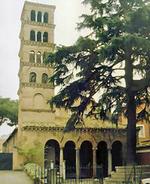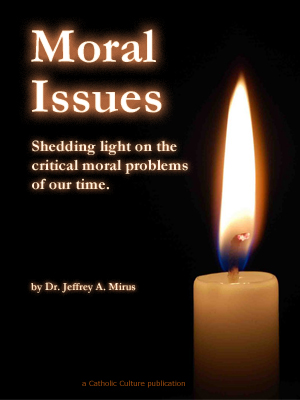Christ, the True Life of Every Soul
by Paolo Risso
On 27 January 2000 the decree regarding a miracle attributed to the Ven. Servant of God Columba Marmion, a professed priest of the Order of St Benedict, was promulgated in the presence of John Paul II.
A life for Jesus
Born in Dublin on Holy Thursday, 1 April 1858, to William Marmion, an Irish gentleman, and to Herminie Cordier, a Frenchwoman, Joseph Marmion received from God an unusual intellectual grasp of his Celtic origins, rich sensitivity, an exuberance of life and perennial youthfulness of soul from the Latin strains in his blood.
The grace of God that he received in Baptism, nourished by frequent and regular Confession and Communion in a pure, clear-sighted adolescence, soon made him an intelligent and jovial seminarian at Clonliffe, with one desire in his heart: "I will be a learned and holy priest". His Archbishop sent him to complete his studies in Rome at the Irish College, where on Ember Saturday of summer, 16 June 1881, he was ordained a priest by Dr Kirby, titular Archbishop of Ephesus.
He returned to his Emerald Isle, where for several months he offered the first fruits of his priesthood in the parish of Dundrum, until Cardinal MacCabe, Archbishop of Dublin, appointed him to the chair of philosophy at the Clonliffe seminary. But studies and teaching for the formation of other priests were not enough for him, impelled as he was by his deep thirst for intimacy with God.
Thus he received Christ's compelling call to the monastic life. In 1886, at the novitiate of Maredsous Abbey in Belgium. On 10 February 1888 he made his first vows, becoming Dom Columba; three years later, in 1891, he made his solemn profession. God would give him 35 years of monastic life: intense, ardent and brilliant.
Having completed his formation, in 1899 he was sent to the Abbey of Mont-Cesar in Louvain, Belgium, where he laboured successfully for about 10 years, enlivened by an intense union with God. In 1909 he was elected Abbot of the monastery of Maredsous: he was that tree which in reaching full maturity produces its richest and most beautiful fruit. It is impossible to give a full account of his life in a few lines; rather we recall some of his books, the fruit of his study and contemplation, of his guidance of souls in spiritual direction and his preaching, which continue to spread such goodness in those who meditate on them and are nourished by them.
"Dom Marmion's providential mission was to bring the source of modern spirituality back to the person itself of Christ", Fr Philippon, O.P., would write of him. In 1901 the latter said to his Abbot: "I have understood that the precious pearl of which the Gospel speaks is Jesus Christ". "If someone asks me: in what does spiritual life consist? I reply: Jesus Christ!". He went to the centre, to the "heart" of Christianity, like John, the beloved disciple, like Paul of Tarsus, the one who most deeply loved the Redeemer: "Jesus Christ is life, Jesus Christ is everything". Dom Marmion wanted to make clear to souls their belonging to Jesus, the source, model and goal of their supernatural life and sanctification, in such a way that their being was immersed in him.
It was in this spirit that he wrote his books: Christ the Life of the Soul, Christ in His Mysteries, Christ the Ideal of the Monk, Christ the Ideal of the Priest, one richer than the other. We will confine ourselves to a brief treatment of the first (Christ the Life of the Soul) which can also be read, meditated on and translated into daily life by the lay Christian faithful. The text, which was published in 1918 and had rapidly spread by 1919 (just 80 years ago), was immediately translated into various European languages; the Italian translation, prepared by Vita a Pensiero, Milan, was the first.
At the 'heart' of the Christian life
Pope Benedict XV kept a copy of it on his desk for personal use and, showing it to Metropolitan Sheptytsky of Lviv, recommended it as the "pure doctrine of the Church". There one senses the fragrance of prayer, of intimacy with God, of the presence of true life, i.e., the divine life, which issues from these marvellous pages by the Abbot of Maredsous. On the morning of 30 January 1923, he went to meet his God immediately after celebrating Holy Mass and reciting, at the end of his thanksgiving, the litany of the Sacred Heart of Jesus.
The one reality that dominates this work, its secret, around which God's plan unfolds, is summarized in St Paul's well-known saying: "Midi vivere Christus est" ("To me life means Christ", Phil 1:21), which is the synthesis of Christian life, from its beginning in Baptism to the goal of heavenly glory. As if taking us by the hand, Dom Columba shows how God's one sublime plan embraces Jesus, his Word made man, and us. Following in the footsteps of St Thomas Aquinas in his presentation of Jesus' mediation in sanctifying our souls, he shows that he, true God and true man, is the unique and universal model of all holiness, the meritorious cause that paid the price for our salvation to divine justice and, lastly, the executor, the effective cause of our holiness.
The second part of the book shows the "work" of the soul that wants to receive and live to the full the divine life whose source is Jesus. Faith in him is the first step towards this life; Baptism, the first of all the sacraments, brings Jesus Christ himself into us and, with the Father and the Holy Spirit, he becomes our truest life: "It is no longer I who live, but Christ who lives in me" (Gal 2:20). The distinguished teacher goes on to explain how we die to sin and live for God by accepting the laws of this divine life and the sources that nourish it: flight from sin, even venial sin, the sacrament of Penance, the Eucharist, the real presence of Christ, Sacrifice and Sacrament (from whom we have everything), prayer, the commitment in charity to perfection as our configuration to Christ, which will reach its fullness in eternal life.
Everything is related to Christ, the source of all light, all grace, all life, all holiness, the centre and the beating "heart" of our deepest and most authentic life: Jesus known, loved, lived and imitated, because he, and he alone, is the true Life of our life.
The Great Jubilee of the Year 2000 must really lead us to live "Christ, the life of the soul", thanks also to the teaching of Dom Columba Marmion.
© L'Osservatore Romano, Editorial and Management Offices, Via del Pellegrino, 00120, Vatican City, Europe, Telephone 39/6/698.99.390.
This item 2961 digitally provided courtesy of CatholicCulture.org






